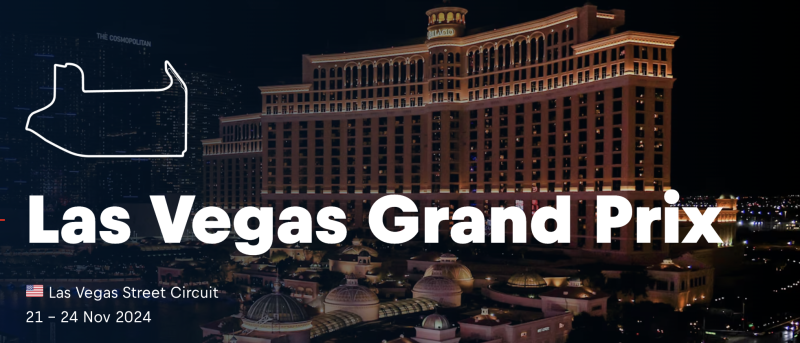This weekend sees Formula 1 racing in Las Vegas for a fourth time. After two events run on a track built up around Caesars Palace in 1981 and 1982, last year Grand Prix racing found a new home in the entertainment capital of the world, with the track using part of the famous Strip from which it takes its name.
The Las Vegas Grand Prix is the third round this year to be held in the United States, following on from Miami and Austin. After the 7.004 kilometre-long Spa-Francorchamps circuit, the Nevadan track is the second longest on the calendar at 6.201 kilometres. It features 17 corners, tackled over 50 times in the race. It is a high speed venue, with three straights and top speeds that hit 350 km/h last year, with several overtaking opportunities, especially at turn 14.
Once again this year, track action begins with two free practice sessions getting the event underway on Thursday, leading up to the race on Saturday night, run entirely under floodlights. There are other events that do the same – Bahrain, Saudi Arabia, Singapore, Qatar and Abu Dhabi – but none feature such a big drop in temperature between day and night as this weekend’s event. This is due to the city’s location in the Mojave desert, while the other four are all just a short distance from the sea. Furthermore, the November date rules out the more usual spring or summer weather enjoyed at most Grands Prix. It is therefore very likely that cars will be running in air temperatures of around 10 °C, with quite similar track temperatures.
As has become the norm for street circuits, Pirelli has selected the three softest compounds in the race, namely the C3 as Hard, the C4 as Medium and the C5 as Soft, as was the case in 2023. The main challenge on the tyre front will be warm-up, especially during qualifying and for the front axle in particular. Drivers will have to be careful to bring the tyres up to temperature without overworking them, avoiding any lock-ups at the heaviest braking points, particularly at the end of the longest straights, along which the tyres will suffer a further reduction in surface temperature. Furthermore, low temperatures lead to a reduction in grip and that can cause increased graining. These factors could lead to a speeding up of the wear process, which suggests a two-stop strategy, which was in fact the most popular choice last year. However, a one-stop can still be quite competitive, especially if the driver gradually brings the tyres up to temperature, prolonging its life over a long stint. Because of the difficulty in warm-up, pitting early to try and make up places with an undercut is not very efficient and in fact, on paper, going longer is a better choice.
Experience gained at last year’s inaugural event will be useful for the teams and for Pirelli. In fact, a great deal of data was acquired relating to grip and the abrasiveness of the track surface and this was shared with the teams, who also provided their simulation data. The first task on arrival at the track will be to check the initial levels of abrasiveness and grip and them compare them with last year’s numbers, making a track inspection and then analysing the data. Smooth and uninterrupted Thursday sessions will be important to produce further data to help make a more accurate prediction relating to tyre degradation and wear.
As always on a street circuit, red flags and Safety Cars are a strong probability with all the unknowns that can bring, including at the restart in terms of tyre temperature management.
In 2023, Max Verstappen won, first past the chequered flag ahead of Charles Leclerc and Sergio Perez. Medium and Hard were the compounds used in the race, the yellow-banded tyre favoured by the majority of drivers on the starting grid.
This year’s Las Vegas Grand Prix will be the 79th round of the Drivers’ World Championship held in the USA since the series started in 1950. The USA thus joins Germany and Great Britain in second place on the list of nations that have hosted the most Grands Prix, with only Italy on 107 having held more. To date, there have been 11 venues used in the United States:Austin (12 Grands Prix), Dallas (1), Detroit (7), Indianapolis (19), Las Vegas (3), Long Beach (8), Miami (3), Phoenix (3), Riverside (1), Sebring (1) and Watkins Glen (20). There’s an unusual statistic in that the two drivers that top the list of winners of races held in the USA will be on track this weekend in Las Vegas, namely Lewis Hamilton and Max Verstappen on six apiece. Following Charles Leclerc’s win in Austin last month, Ferrari is the most successful team in this country on 14 wins.
Apart from Formula 1, in Las Vegas Ferrari will also be involved in a one-off event for 35 Prancing Horse competitors in the North American series of the Ferrari Challenge Trofeo Pirelli driving their 296 Challenge cars, all shod with Pirelli tyres, a Ferrari partner in this series since it was established in 1993.






Leave A Comment